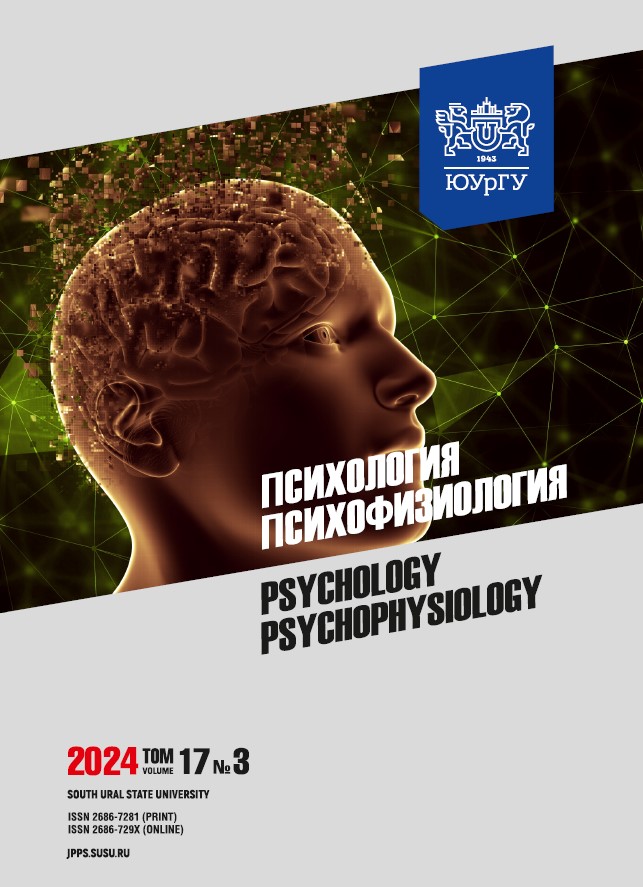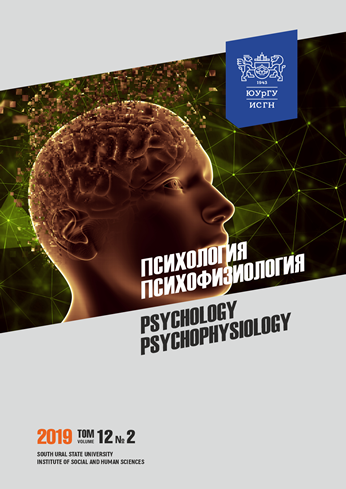Developing a psychophysiological method to examine violations of predictive coding processes
Abstract
Introduction. The predictive coding theory posits that the brain functions as a “prediction machine”, continuously generating hypotheses based on past experiences and comparing them against actual input signals. This theory is a promising basis for explaining many psychopathological mechanisms. However, experimental approaches to investigate predictive coding processes have not been sufficiently explored. The article introduces a novel psychophysiological method designed to investigate the characteristics of predictive coding processes during variable visual stimulation. The paper outlines the experimental protocol, detailing the scenarios for stimulation, data acquisition, processing, and interpretation. The paper describes the experimental design and presents preliminary results from a pilot study. Aims: to develop a psychophysiological method to examine violations of predictive coding in healthy individuals and patients with schizophrenia. Materials and methods. A psychophysiological method has been developed aimed at exploring the predictive coding process during variable visual stimulation. The methodology includes electroencephalographic (EEG) and electrooculographic (EOG) recordings during a saccade task. The method was validated on a sample of 22 participants: 10 healthy individuals and 12 patients diagnosed with schizophrenia. The contingent negative variation and the P300 component, reflecting predictions and prediction error detection, were selected as psychophysiological indicators to evaluate predictive coding processes. Results. Experimental alterations in probability do not affect the studied psychophysiological parameters (topography and amplitude of the CNV and P300) among patients with schizophrenia, as opposed to mentally healthy people. Conclusion. The results obtained confirm the existence of differences in predictive coding processes between mentally healthy individuals and patients with schizophrenia under the conditions proposed in the experimental methodology.
Downloads
References
2. Wynn J.K., Green M.F. An EEG-Based Neuroplastic Approach to Predictive Coding in People With Schizophrenia or Traumatic Brain Injury. Clinical EEG Neuroscience. 2024;6:15500594241252897. DOI: 10.1177/15500594241252897.
3. Sapey-Triomphe L.A., Sanchez G., Hénaff M.A. et al. Disentangling sensory precision and prior expectation of change in autism during tactile discrimination. NPJ Scientific Learning. 2023;8(1):54. DOI: 10.1038/s41539-023-00207-5.
4. Spaeth A.M., Koenig S., Everaert J. et al. Are depressive symptoms linked to a reduced pupillary response to novel positive information? – An eye tracking proof-of-concept study. Frontiers in Psychology. 2024;23(15):1253045. DOI: 10.3389/fpsyg.2024.1253045.
5. Tucker D.M., Luu P. Motive control of unconscious inference: The limbic base of adaptive Bayes. Neuroscience and Biobehavioral Reviews. 2021;128:328–345. DOI: 10.1016/j.neubiorev.2021.05.029.
6. Hipólito I., Kirchhoff M. Breaking boundaries: The Bayesian Brain Hypothesis for perception and prediction. Consciousness and Cognition. 2023;111:103510. DOI: 10.1016/j.concog.2023.103510.
7. Sprevak M., Smith R. An Introduction to Predictive Processing Models of Perception and Decision-Making. Topics in Cognitive Science. 2023;(28):1–28. DOI: 10.1111/tops.12704.
8. de Lange F.P., Heilbron M., Kok P. How Do Expectations Shape Perception. Trends in Cognitive Science. 2018;22(9):764–779. DOI: 10.1016/j.tics.2018.06.002.
9. Syrov N., Yakovlev L., Miroshnikov A. et al. Beyond passive observation: feedback anticipation and observation activate the mirror system in virtual finger movement control via P300-BCI. Frontiers in Human Neuroscience. 2023;4(17):1180056. DOI: 10.3389/fnhum.2023.1180056.
10. Qin C., Michon F., Onuki Y. et al. Predictability alters information flow during action observation in human electrocorticographic activity. Cell Reports. 2023;42(11):113432. DOI: 10.1016/j.celrep.2023.113432.
11. Scott M. Sensory attenuation from action observation. Experimental Brain Research. 2022;240(11):2923–2937. DOI: 10.1007/s00221-022-06460-1.
12. Ashraf R., Abdoli B., Khosrowabadi R. et al. The Effect of Modeling Methods on Mirror Neuron Activity and a Motor Skill Acquisition and Retention. Basic Clinical Neuroscience. 2023;14(5):631–646. DOI: 10.32598/bcn.2021.3245.1.
13. Ji Q., Liu L., Lu Y. et al. Mechanisms of Action Anticipation in Table Tennis Players: A Multivoxel Pattern Analysis Study. Neuroscience. 2024;16:33–40. DOI: 10.1016/j.neuroscience.2024.03.016.
14. Murphy C.P., Runswick O.R., Gredin N.V. et al. The effect of task load, information reliability and interdependency on anticipation performance. Cognitive Research: Principles and Implications. 2024;9(1):22. DOI: 10.1186/s41235-024-00548-8.
15. Amoruso L., Pusil S., García A.M. et al. Decoding motor expertise from finetuned oscillatory network organization. Human Brain Mapping. 2022;43(9):2817–2832. DOI: 10.1002/hbm.25818.
16. Wang Y., Zhao Q., Ji Q. et al. fMRI evidence of movement familiarization effects on recognition memory in professional dancers. Cerebral Cortex. 2024;34(1):bhad490. DOI: 10.1093/cercor/bhad490.
17. Ueda S., Sato T., Kumada T. Model-Based Prediction of Operation Consequences When Driving a Car to Compensate for a Partially Restricted Visual Field by A-Pillars. Frontiers in Human Neuroscience. 2021;15:697295. DOI: 10.3389/fnhum.2021.697295.
18. Schwartenbeck P., FitzGerald T.H., Mathys C. et al. The Dopaminergic Midbrain Encodes the Expected Certainty about Desired Outcomes. Cerebral Cortex. 2015;25(10):3434–3445. DOI: 10.1093/cercor/bhu159.
19. Chew B., Hauser T.U., Papoutsi M. et al. Endogenous fluctuations in the dopaminergic midbrain drive behavioral choice variability. Proceedings of the National Academy of Sciences of the USA. 2019;116(37):18732–18737. DOI: 10.1073/pnas.1900872116.
20. Posner M.I. Orienting of attention: Then and now. Quarterly Journal of Experimental Psychology. 2016;69(10)1864–1875. DOI: 10.1080/17470218.2014.937446.
21. Del Popolo Cristaldi F., Mento G., Sarlo M. et al. Dealing with uncertainty: A high-density EEG investigation on how intolerance of uncertainty affects emotional predictions. PLoS One. 2021;16(7):e0254045. DOI: 10.1371/journal.pone.0254045.
22. Gómez C.M., Arjona A., Donnarumma F. et al. Tracking the Time Course of Bayesian Inference With Event-Related Potentials:A Study Using the Central Cue Posner Paradigm. Frontiers in Psychology. 2019;10:1424. DOI: 10.3389/fpsyg.2019.01424.
23. Brown H.R., Friston K.J. The functional anatomy of attention: a DCM study. Frontiers in Human Neuroscience. 2013;7:784. DOI: 10.3389/fnhum.2013.00784.
24. Auksztulewicz R., Friston K. Attentional Enhancement of Auditory Mismatch Responses: a DCM/MEG Study. Cerebral Cortex. 2015;25(11):4273–4283. DOI: 10.1093/cercor/bhu323.
25. Sanquist T.F., Beatty J.T., Lindsley D.B. Slow potential shifts of human brain during forewarned reaction. Electroencephalography and Clinical Neurophysiology. 1981;51(6):639–649. DOI: 10.1016/0013-4694(81)90208-x
26. Fitzgerald K., Todd J. Making Sense of Mismatch Negativity. Frontiers in Psychiatry. 2020;11:468. DOI: 10.3389/fpsyt.2020.00468.
27. Chennu S., Noreika V., Gueorguiev D. et al. Expectation and attention in hierarchical auditory prediction. Journal of Neuroscience. 2013;33(27):11194–11205. DOI: 10.1523/JNEUROSCI.0114-13.2013.
28. Ivanov M.V., Tumova M.A., Kapustina T.V., Muslimova L.M. Information processing disorders in patients with schizophrenia: a literature review. Sibirskii vestnik psikhiatrii i narkologii = Siberian Herald of Psychiatry and Addiction Psychiatry. 2020;2(107):41–50. (in. Russ.). DOI: 10.26617/1810-3111-2020-2(107)-41-50.
29. Guseinova Z.T., Tumova M.A., Shoshina I.I. Features of the visual system in patients with paranoid schizophrenia. Psikhiatriya = Psychiatry (Moscow). 2022;20(S3(2)):12–14. (in. Russ.).
30. Kirenskaya A.V., Myamlin V.V., Novototsky-Vlasov V.Y. et al. The contingent negative variation laterality and dynamics in antisaccade task in normal and unmedicated schizophrenic subjects. Spanish Journal of Psychology. 2011;14(2):869–883. DOI: 10.5209/rev_sjop.2011.v14.n2.34.
31. Errington S.P., Schall J.D. Express saccades during a countermanding task. Journal of Neurophysiology. 2020;124(2):484–496. DOI: 10.1152/jn.00365.2020.
32. Gouret F., Pfeuffer C.U. Anticipatory Saccades Towards the Future Consequences of Ones Actions – an Online Eye Tracking Study. Journal of Cognition. 2023;6(1):15. DOI: 10.5334/joc.261.
33. Thibault N., Albouy P., Grondin S. Distinct brain dynamics and networks for processing short and long auditory time intervals. Scientific Reports. 2023;13(1):22018. DOI: 10.1038/s41598-023-49562-8.
34. Slavutskaya M.V., Shulgovsky V.V., Semina T.K. Directed attention influence on the human brain potentials under conditions of probability visual stimulation. Zhurnal vysshei nervnoi deyatelnosti im. I.P. Pavlova = I.P. Pavlov Journal of Higher Nervous Activity. 2005;55(6):796–805. (in. Russ.).
35. Yordanova J., Falkenstein M., Kolev V. Motor oscillations reveal new correlates of error processing in the human brain. Scientific Reports. 2024;14(1):5624. DOI: 10.1038/s41598-024-56223-x.
36. Osborne K.J., Kraus B., Lam P.H. et al. Contingent Negative Variation Blunting and Psychomotor Dysfunction in Schizophrenia: A Systematic Review. Schizophrenia Bulletin. 2020;46(5):1144–1154. DOI: 10.1093/schbul/sbaa043
37. Dharani R., Goyal N., Mukherjee A. et al. Adjuvant High-Definition Transcranial Direct Current Stimulation for Negative Symptoms in Schizophrenia: A Pilot Study. The Journal of ECT. 2021;37(3):195–201. DOI: 10.1097/YCT.0000000000000756.
38. Kumar N., Vishnubhatla S., Wadhawan A.N. et al. A randomized, double blind, sham-controlled trial of repetitive transcranial magnetic stimulation (rTMS) in the treatment of negative symptoms in schizophrenia. Brain Stimulation. 2020;13(3):840–849. DOI: 10.1016/j.brs.2020.02.016.
39. Vidal-Gran C., Sokoliuk R., Bowman H. et al. Strategic and Non-Strategic Semantic Expectations Hierarchically Modulate Neural Processing. eNeuro. 2020;7(5):ENEURO.0229-20.2020. DOI: 10.1523/ENEURO.0229-20.2020.
40. Dehaene S., Changeux J.-P. Experimental and theoretical approaches to conscious processing. Neuron. 2011;70(2):200–227. DOI: 10.1016/j.neuron.2011.03.018
41. Yasoda-Mohan A., Vanneste S. Development, Insults and Predisposing Factors of the Brains Predictive Coding System to Chronic Perceptual Disorders-A Life-Course Examination. Brain Sciences. 2024;14(1):86. DOI: 10.3390/brainsci14010086.
42. Tivadar R.I., Knight R.T., Tzovara A. Automatic Sensory Predictions: A Review of Predictive Mechanisms in the Brain and Their Link to Conscious Processing. Frontiers in Human Neuroscience. 2021;15:702520. DOI: 10.3389/fnhum.2021.702520.
43. Sikkens T., Bosman C.A., Olcese U. The Role of Top-Down Modulation in Shaping Sensory Processing Across Brain States: Implications for Consciousness. Frontiers in Systems Neuroscience. 2019;13:31. DOI: 10.3389/fnsys.2019.00031.
44. Fu Z., Sajad A., Errington S.P. et al. Neurophysiological mechanisms of error monitoring in human and non-human primates. Nature Reviews Neuroscience. 2023;24(3):153–172. DOI: 10.1038/s41583-022-00670-w.
45. Gillan C.M., Fineberg N.A., Robbins T.W. A trans-diagnostic perspective on obsessive-compulsive disorder. Psychological Medicine. 2017;47(9):1528–1548. DOI: 10.1017/S0033291716002786.
46. Sajad A., Godlove D.C., Schall J.D. Cortical microcircuitry of performance monitoring. Nature Neuroscience. 2019;22(2):265–274. DOI: 10.1038/s41593-018-0309-8
References on translit
-Copyright (c) 2024 Psychology. Psychophysiology

This work is licensed under a Creative Commons Attribution-NonCommercial-NoDerivatives 4.0 International License.



